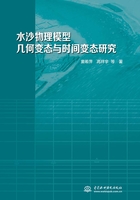
上QQ阅读APP看本书,新人免费读10天
设备和账号都新为新人
2.1 潮流的相似条件
在以x、y、z表示的直角坐标系中,流体运动基本方程具有如下形式:




式中:u、v、w分别为x、y、z方向上的时均流速分量;t为时间;p为压力;ρ为水的密度;![]() 和
和![]() 等为紊动应力。
等为紊动应力。
当x轴取河道纵向方向、y轴取河道横向方向、z轴以河底为原点并垂直向上,则上述方程组可写为




式中:g为重力加速度;ix和iy分别为纵向和横向水面比降。
对于一般河流、河口和海岸区的水流,其水面上的压力就是大气压力,沿x和y方向的变化均很小,一般可忽略不计,因而有

除了紧靠建筑物的局部区域,压力随水深的变化一般均接近静水压力分布,即p=ρg(h-z),因而有

式(2.4a)中的![]() 基本上保持为常值[140],则有
基本上保持为常值[140],则有

而水平方向紊动切应力![]() 和
和![]() 均从水面向河底接近直线增大,因而可分别近似表示为
均从水面向河底接近直线增大,因而可分别近似表示为

式中:C0为无尺度谢才系数;C为谢才系数;U和V分别为垂线平均流速在x和y方向的分量;h为水深。
考虑到上述各简化计算式并忽略水的黏滞阻力,可以得到潮流运动方程:




如果上述方程组中的各项均能按相同的比例缩小,则模型中的水流就能与原型相似。将各模型量代入式(2.1b)~式(2.4b)中,得到下列方程,其中λ为比尺,表示原型量与模型量的比值,其下标m表示相应的模型量,下标p表示相应的原型量。




若式(2.5)两边同除以![]() ,可得到
,可得到

若式(2.6)两边同除以![]() ,可得到
,可得到

若式(2.7)两边同除以![]() ,可得到
,可得到

若式(2.8)两边同除以![]() ,可得到
,可得到

模型的水流运动满足连续方程和运动方程的条件是

当水平比尺相同时,即λx=λy=λl时,得到模型水流与原型水流的相似条件为




式(2.9)~式(2.11)由惯性力与重力比尺相同而得,称其为重力相似条件;式(2.12)由惯性力与阻力比尺相同而得,故称之为阻力相似条件。上述相似条件既适用于正态模型,也适用于变态模型。